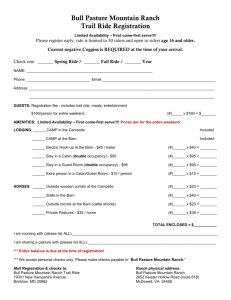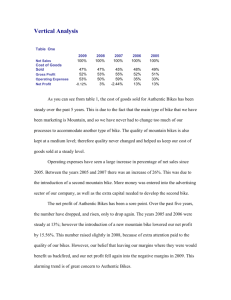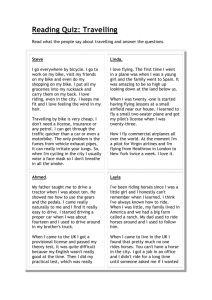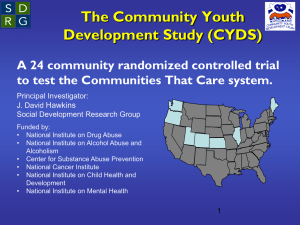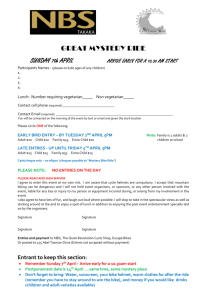Unit 1 - Ride Preparation: Trail Mountain Bike Leader Resource
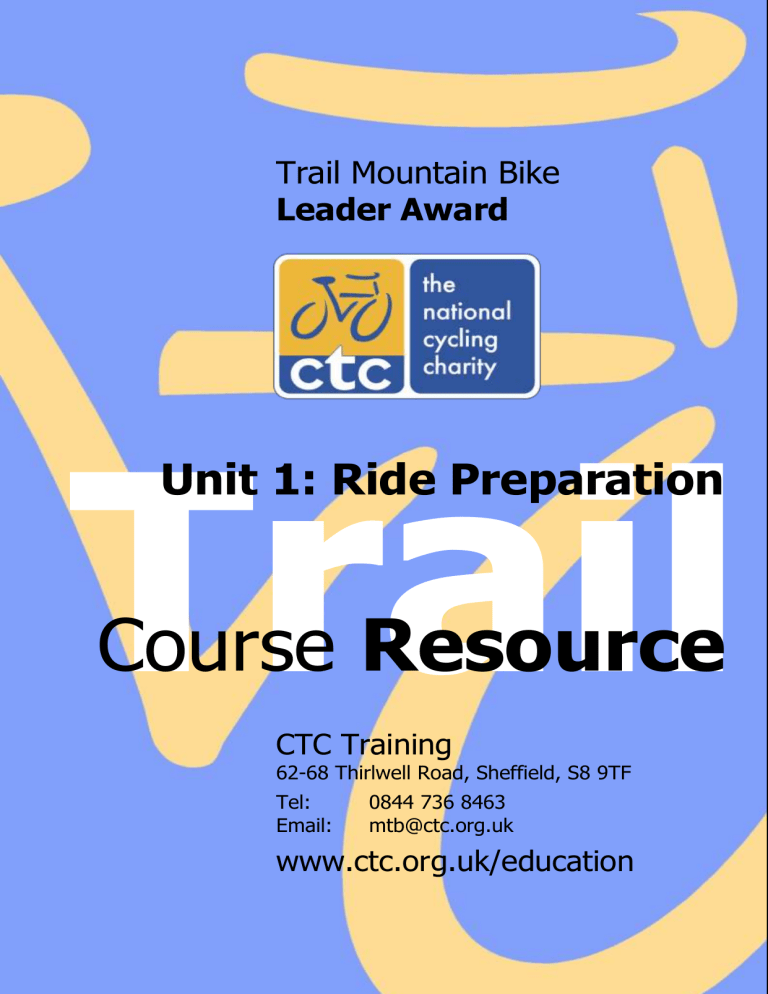
Trail Mountain Bike
Leader Award
Leader & Instructor
Awards
CTC Training
62-68 Thirlwell Road, Sheffield, S8 9TF
Tel: 0844 736 8463
Email: mtb@ctc.org.uk www.ctc.org.uk/education
TRAIL MOUNTAIN BIKE LEADER AWARD
Leader Resource - Ride Preparation
Contents
Title
Introduction
CTC
Section 3 – Best Practice Guide
Unit 1 – Ride Preparation
Risk Assessment
Operating Procedures
Environment
Equipment
Contacting CTC
Link
Go there
Go there
© Copyright CTC 1996-2013
All rights reserved. No part of this publication may be reproduced in any form or by any means without permission from the publishers.
To ensure that maintenance of appropriate and high standards of the Awards, CTC reserves the right to alter any course specification or detail without notice.
© Copyright CTC 2012 – 13 Page 2 of 24
Page
3
7
11
14
17
3
4
5
24
TRAIL MOUNTAIN BIKE LEADER AWARD
Leader Resource - Ride Preparation
Unit 1 – Ride Preparation
Welcome to your Trail Mountain Bike Leader Resource. This resource is designed to aid your role as an excellent CTC mountain bike leader now and in the future. You should find that you need to refer to it regularly even when leading often, as its content is entirely applicable to your circumstances.
This resource is made up of several individual sections, which this is a section of part 3:
1.
Information on the Trail Mountain Bike Leader Award, how this fits within the National
Mountain Bike Leader Award Scheme and the National Mountain Bike Skill Awards.
2.
CTC products and services and how these improve and enable the environment for all cyclists and mountain biking.
3.
Best practice information and principles for each section of the Trail Leader Award
Scheme. These sections are presented in the same unit order as the qualification itself.
4.
Your Logbook for the recording of future personal and leading rides that you undertake, and ensuring your CPD is recorded
5.
Pro-formas and exemplar forms for you to use in applying CTC’s best practice in documenting your methods.
All sections are available separately as downloads from Trail Leader Resource page.
CTC
CTC, the national cycling charity administers and provides the National Mountain Bike Leader
Award Scheme as a National Governing Organisation. Its purposes in doing this are to enable best practice in activity provision and accessibility to help engage millions of people in mountain biking and cycling.
At CTC:
1.
We protect cyclists
2.
We inspire people to cycle
3.
We promote cycling
4.
We operate a highly effective organisation
CTC provide a wide range of services to assist Mountain Bike Leaders both in their role as leaders and as individuals. More information about CTC is available in the CTC support and services downloadable documents and at www.ctc.org.uk
.
© Copyright CTC 2012 – 13 Page 3 of 24
TRAIL MOUNTAIN BIKE LEADER AWARD
Leader Resource - Ride Preparation
Section 3 - Best Practice Guide
Unit 1:
Unit 2:
Unit 3:
Unit 4:
Unit 5:
Unit 6:
Unit 7:
Unit 8:
Unit 9:
Unit 10:
This section is made up of all the units that comprise the Trail Leader Award qualification and is a guide to implementing best practice in these core areas. Each section covers all aspects of how to plan and deliver led rides safely to a high level of competence. You should refer to this section regularly as its content is of key importance to keeping you at the appropriate standard for mountain bike leading. It can also be used as a tool to outline essential aspects of mountain bike practice and safety to the individuals you are working with.
Each unit covers a select area of importance with sub sections underlining the key points that fall under that heading. The units are ordered as follows:
Unit Title
Ride preparation
Riding ability
Instruct others riding skills
Trailside maintenance
Navigation
Pre-ride checks
Leading groups
Dealing with emergencies
Environment
Ending the ride
Each unit can be downloaded from the Trail Leader Award Resource page.
© Copyright CTC 2012 – 13 Page 4 of 24
TRAIL MOUNTAIN BIKE LEADER AWARD
Leader Resource - Ride Preparation
Unit 1: Ride preparation
Quality preparation for a mountain bike session or ride is one of the key contributors to success. The volume, type and requirements of preparation will vary every time, dependant on its influencing factors:
People involved, their experience, needs, desires and skill level – participants, assistants, base contacts, other countryside users and you.
Environment – the area and potential routes being used and the previous, current and forecast weather and the season.
Equipment available, its source, capacities and suitability.
For any session, this involves a deal of preparatory work in discovery: communication with people beforehand; identifying and visiting the potential area and investigating the likely circumstances of the day.
Essentially this splits down into a three stage process:
Initial Stage
Some time prior to session:
1.
Determine preliminary information about information to
people.
2.
Visit area and outline
3.
Generate
environment
(route and route options) – the
Pre-ride
.
Risk Assessment.
4.
Identify if necessary.
Operating Procedures people
and
equipment
including providing
are sufficient and appropriate. Regenerate where
Secondary Stage
With the session imminent:
1.
Verify and update information about
2.
Identify
environment people
and
equipment
with changes.
(weather current and forecast, route and route options).
3.
Modify plans as required.
4.
Generate base contact information, provide and discuss with them.
Final Stage
The first part of the session itself:
1.
Verify information about
2.
Verify
environment people
and
equipment.
(weather current and forecast).
3.
Modify plans with changes as required.
4.
Communicate final ride details, departure and return times with base contact.
© Copyright CTC 2012 – 13 Page 5 of 24
TRAIL MOUNTAIN BIKE LEADER AWARD
Leader Resource - Ride Preparation
Clearly a continuous monitoring and adaption process (dynamic risk assessment) is required throughout the session as well.
It may be that much of this information is already known or has been generated through previous work for some of your sessions or rides. Where this is the case, the first stage may be very quick and verification becomes the key process.
© Copyright CTC 2012 – 13 Page 6 of 24
TRAIL MOUNTAIN BIKE LEADER AWARD
Leader Resource - Ride Preparation
Risk Assessment
As part of your Trail Leader course, you generated part of a competence. A typical
Risk Assessment
to show your
Risk Assessment
(table 1) comprises four parts
Hazards
Who Might Be
Harmed
Controls to
Minimize Risk
Residual Risk
Table 1: A typical Risk Assessment
Hazards are the potential causes of incident or accident. This could include anything from a busy road crossing, a steep drop or uncooperative behaviour. Often factors that involve specific emergency actions such as head injury, although a cause rather than a hazard in themselves, have such a critical effect that they are listed for consideration.
Who might be harmed is usually obvious, but do not forget to include those not part of your group, such as other countryside users, and yourself.
The controls to minimise risk are a crucial element to successful mountain bike leading.
Reducing risk may also reduce opportunities. Exposure to controlled risk is a developmental process all activity participants need to go through. The level of acceptable (or residual) risk is the balance between the benefit of doing the activity and the likelihood and consequences of harm occurring to those participating.
The residual risk should then be identified as acceptable or unacceptable. From here, the activity should go ahead (where all the risks are acceptable), not go ahead (if one or more risks are unacceptable). If the latter, then there may be
The Five Steps to Risk Assessment
The
Risk Assessment
process itself is made up of five steps:
1.
Identify the hazards.
2.
Consider who may be harmed.
3.
Determine how to control the hazards to avoid potential injury or incident.
4.
Review.
5.
Ongoing (dynamic) risk assessment must also take place throughout the activity.
© Copyright CTC 2012 – 13 Page 7 of 24
TRAIL MOUNTAIN BIKE LEADER AWARD
Leader Resource - Ride Preparation
Mountain Bike Leading Hazards
Some hazards for many mountain bike risk assessments might include (but not necessarily be limited to):
Activity related soft tissue injury
Adverse weather
Collision with other users
Equipment failure
Fall from bike
Food or fluid poisoning
General accidents
Head injury
Hyperthermia
Hypothermia
Leader injured or incapacitated
Participant lost or separated from group
Road traffic accident
Slips and trips
Stress caused by activity and inherent challenges
Uncooperative participant behaviour
Wildlife attack – dog, cattle, tick, wasp
All the identified hazards should then be matched to the people potentially affected.
Who may be harmed?
Consider that some or all of the following people categories may be affected as a result of the above hazard:
Participants
Leader
Assistants
General public
Venue staff
© Copyright CTC 2012 – 13 Page 8 of 24
TRAIL MOUNTAIN BIKE LEADER AWARD
Leader Resource - Ride Preparation
Minimising the risk
Introducing controls to minimise the risk is the third stage of the process. These will vary noticeably according to the circumstances; environment and people involved, and cannot therefore be detailed within this resource. You did, however discuss suitable controls as part of your course.
Some sample controls might by categorised into the following elements:
Equipment carried and used by the Leader (e.g. first aid kit, group shelter).
Equipment and clothing used and worn by the participants (e.g. appropriate clothing, waterproofs being carried).
Adaption’s to the session (e.g. use of route options).
Group management techniques (e.g. leader position).
Preparatory work (e.g. pre-ride, obtaining up to date weather forecast).
Anticipative evaluations (e.g. having the experience and judgement to make decisions prior to issues arising – such as matching the route to the groups physical capacities, or ensuring the participants drink regularly).
Reactive actions (e.g. tick check and removal).
Residual risk
The key principle of a risk assessment is to ensure that sufficient controls are in place to reduce risks to an acceptable level, yet still enable the provision and benefit of opportunity.
The judgement of the level of this
residual risk
Where you are uncertain about the level of is therefore crucial and demands both consideration and experience. As a Trail Leader you have shown sufficient competence to make decisions in managing groups within the Trail Leader specifications of limits.
residual risk
, you should seek technical advice from an appropriately qualified expert. Where required, CTC provide a Technical Advisory service.
A sample Risk Assessment form is available in the Pro-forma section.
© Copyright CTC 2012 – 13 Page 9 of 24
TRAIL MOUNTAIN BIKE LEADER AWARD
Leader Resource - Ride Preparation
Dynamic Risk Assessments
A paper based risk assessment may be a one off process (though reviewed at least annually), where regularly repeated activities occur. Where in a more dynamic environment, for example when using new areas or different routes not often used, additional session specific risk assessments may also be generated to aid the preparatory process.
Further, as a Trail Leader, you have to continually make judgements about what you and your participants are doing. You evaluating your participants’ capacity to deal with the circumstances you are placing them in, and this depends a great deal on your own experience and capacity to anticipate.
As a Trail Leader one of your key roles is to match the upcoming activities to the capacities of your group. This formed a key part of your Trail Leader course where you proved your ability to anticipate and to make judgement calls. Remember that this should always continue throughout every ride you lead.
More information
Discover more about risk assessments and the risk assessment process at the Health and
Safety Executive website.
© Copyright CTC 2012 – 13 Page 10 of 24
TRAIL MOUNTAIN BIKE LEADER AWARD
Leader Resource - Ride Preparation
Operating Procedures
Your risk assessment should then lead to the development of
operating procedures
. These are documents identifying methods and processes to use in defined circumstances. Where you work in an organisation of five or more employees, you are legally required to have written operating procedures. Where you work in a smaller environment than this, the process of generating and using operating procedures remains extremely useful.
Potential Operating Procedures:
An operating procedure is a method to implement in a defined circumstance or to deal with a given situation.
A SOP (standard Operating Procedure) is a written document/instruction detailing all the steps and activities of a process or procedure
Operating procedures you are likely to need to generate may include:
General Operating Procedures for mountain biking.
Late back procedure.
Equipment policy.
Incident and accident procedure.
Incapacitated instructor procedure (for participants).
Safeguarding children and adults.
It makes it easier to reduce each operating procedure’s size where you refer to other operating procedures at appropriate points.
© Copyright CTC 2012 – 13 Page 11 of 24
TRAIL MOUNTAIN BIKE LEADER AWARD
Leader Resource - Ride Preparation
For each procedure, you might include elements from:
1.
General procedure – e.g. leader expectations and applications.
2.
Preparatory work.
3.
Actions to take at the time.
4.
Subsequent requirements.
© Copyright CTC 2012 – 13 Page 12 of 24
TRAIL MOUNTAIN BIKE LEADER AWARD
Leader Resource - Ride Preparation
Steps prior to delivering your ride
There are a variety of stages and processes to go through prior to actually delivering your mountain bike led ride.
People and Information
As was outlined in the generation of the operating procedures during your course, much of the work you undertake as a
Leader is based around the people involved.
Wherever this is the case, communication is a critical component. As part of the preparation for any mountain bike session, you should consider the need to inform those who may be involved. This may include any or all of:
Participants
Parents or guardians
Group leader (youth worker, teacher, person co-ordinating the group).
Assistant Leader
Base contact
Your employer, or work co-ordinator where within a voluntary group.
Landowner or venue (for example forestry commission need informing where groups are using their land, and commercial groups may need to pay for an access licence).
Remember that information is very much a two way process. You will also require information from, for example, the participants to be able to prepare your session to meet their needs and circumstances.
Equally they will need information to determine several aspects of their own consideration prior to the ride. Not least of these is whether they want to go in the first place; is mountain biking right for them? By the same token, they (or their parents/guardians) need to know elements such as:
Where and when
Aims of the session – what they should gain, personal development, riding skills, enjoyment, navigation etc).
How far and how long they may be riding, and how achievable this should be.
Pre-requisites (i.e. able to ride a bike, or prior experience).
Your experience and qualifications.
A management style you will use to ensure the safety of your group members at all times.
Contact number (provide the base contact number here, so you are not flooded with calls when you are 10 minutes late returning).
What to wear
© Copyright CTC 2012 – 13 Page 13 of 24
TRAIL MOUNTAIN BIKE LEADER AWARD
Leader Resource - Ride Preparation
What to bring
What not to bring (e.g. drinks in glass bottles).
What to be aware of – expectations (e.g. that Sikh participants may need to remove their turban to wear a helmet – in this case they may decline or agree, based on being able to leave their hair tied up in line with religious requirements.).
Sample forms for you and your participants to complete are provided within the pro-forma section.
Environment
Pre-ride
Once you know the likely capacities of your participants, along with the area they are based or can access, potential ride routes and session areas can be identified. Although some access and potential can be identified from the map a true picture of the terrain and environment can only be determined through a pre-ride.
Your pre-ride should:
Identify that routes remain within the Trail Leader specification of limits;
Generate a route and route options that are likely to be within your groups capacities;
Provide suitable locations and sections within the ride or session to cover pre-ride checks and activities; skills development games opportunities;
Identify any changes or potential changes since you last used the route;
© Copyright CTC 2012 – 13 Page 14 of 24
TRAIL MOUNTAIN BIKE LEADER AWARD
Leader Resource - Ride Preparation
Enable the modification of the route prior to or during the ride where circumstances within the group, or external factors (such as deterioration of weather conditions);
Enable you to identify appropriate group management techniques including: o Leader position o Stopping points o Communication;
Provide a method to make ride notes as per the technique used during your Trail
Leader Award course.
Even where you use a route regularly, changes can occur: car boot sales can be set up for your ride day; access land can be closed; trees can fall across the track; dry easy tracks can become un-rideable with changes in season and rainfall and so on. It is recommended that routes are pre-ridden as close to the ride day as possible to ensure that your review is up to date.
Where you are using a new area, it may be worthwhile identifying potential routes and riding these well in advance to begin to formulate the best route, direction and options some time before the ride. This aids your opportunity to find another area where you find the riding is unsuitable.
© Copyright CTC 2012 – 13 Page 15 of 24
TRAIL MOUNTAIN BIKE LEADER AWARD
Leader Resource - Ride Preparation
Weather
Modern forecasts are both accessible and accurate. There is no need to understand synoptic charts (weather maps) at Trail Leader level, but you should ensure that you obtain appropriate and up to date forecasts a few days prior to the ride, as well as the day prior and immediately before the ride.
Quality forecasts can be obtained from radio, TV, fax and phone, and the internet. The forecast source should be updated regularly (i.e. yesterdays paper, however detailed is inappropriate). You should ensure that your forecast is not a 30 second resume of what might be happening outside the local radio station, but provides you with all the information required by the
Trail Leader specification of limits, namely:
Temperature
Rainfall
Wind speed and direction
Visibility
This should include the forecast immediately prior to, during and following your ride schedule, as this enables you to make a valued decision on weather changes whilst out on the ride. For example, the indications for decent weather may be there for the morning, with cloud building during the day and heavy rain during the evening. When out on the days ride you will need to be aware of this and identify if the rain is likely to affect you due to a faster moving weather pattern than first thought.
Phone apps, such as that from the Met Office can provide additional advance warning (note the rainfall warning issued on the image above).
There are other sources available, but suitable internet forecasts are provided by:
BBC Weather
Metcheck
Met Office
MWIS
© Copyright CTC 2012 – 13 Page 16 of 24
TRAIL MOUNTAIN BIKE LEADER AWARD
Leader Resource - Ride Preparation
Equipment
Equipment available, it’s source, capacities and suitability
Finding out information about the participants should provide indicators on the likely availability of suitable clothing and equipment. It is clearly inappropriate to expect most group members to provide specialist mountain biking clothing. Therefore one of your key tasks is to identify potential accessible clothing alternatives, as well as to determine the appropriateness of equipment they might bring with them, for example bike condition).
Clearly with specialist equipment, you may have to provide your own, or seek out locations that can provide it. We would recommend that you use CTC accredited venues as their equipment, services and reliability will be of high quality.
Trail Equipment
The list provided in table 2 below includes for virtually all suitable Trail Leader conditions and circumstances, so where the weather is good, the route short, the area very limited, the season being the summer or other reducing factor, the equipment needed may be somewhat reduced.
Of course all equipment should be suitable and capable to perform its task. Rarely used equipment, notably that of the Leader should be checked and verified for its condition on a regular basis.
© Copyright CTC 2012 – 13 Page 17 of 24
TRAIL MOUNTAIN BIKE LEADER AWARD
Leader Resource - Ride Preparation
Group members are likely to need most or all of:
Participants: Assistant Leader
Suitable clothing
Suitable footwear
Bike
Helmet
Spare clothing
Food and drink
Waterproof
Inner tube
Personal medical requirements
All that worn and carried by the participants and:
Map
Compass
Lights
Hi viz jacket and/or rucksack cover
Pump
Incapacitated
Leader details
Base contact details
Multi tool
Trail Leader
All that worn and carried by the participants and assistant and:
First aid kit
Tyre levers
Participants, Assistant and own medical details
Pen and paper
Emergency form (see pro-forma section)
Hot drink
Exposure bag
Group shelter
Additional spare clothes
Additional tools and spares – zip ties, tyre patch etc
Puncture repair kit
Whistle
Additional telephone change
Mobile phone, charged, credited and inside a waterproof carrier
Sleeping bag or duvet jacket
Outline of intended route
Table 2: Equipment that may be needed for a Trail Leader ride.
Clothing
Baseline information on clothing is provided here due to fact that the right choice of clothing can not only make a ride more enjoyable for both the leader and members, but it can make the whole ride significantly safer, reducing the possibility of hypo/hyperthermia and injury.
Partaking in an active sport, such as mountain biking presents particular problems to clothing and therefore to the body. This is especially true during the British winter, when low temperatures and high wind chill factors combine; climbing long ascents can be very hot, yet on reaching the top, waiting around, or the descent down the other side may be extremely cold.
© Copyright CTC 2012 – 13 Page 18 of 24
TRAIL MOUNTAIN BIKE LEADER AWARD
Leader Resource - Ride Preparation
Layering
Contrary to popular belief, it is not clothes that keep someone warm: it is the air held within clothes and in between the layers of clothes which do this. This trapped air is warmed through body heat, providing insulation against the colder open air. Obviously the colder it becomes, the more layers of trapped air are required. Layering also assists in keeping the body at constant temperature as when several layers are worn the removal or addition of one at a time adjusts the insulation appropriately. If only one or two layers are used however, small variations in the insulation cannot be made.
The material used can also hold varying amounts of tog (warmth) rating. The growth in availability of fleece is indicative of this materials ability to retain warmed air within it, even when wet. Other materials are much less effective at this, such as thin cotton and denim.
Different layers have different uses. These are the four basic garment categories: not all are always necessary yet when the temperature is cold, multiples of each layer may be required.
© Copyright CTC 2012 – 13 Page 19 of 24
TRAIL MOUNTAIN BIKE LEADER AWARD
Leader Resource - Ride Preparation
The Under Layer (sometimes called the base layer)
Next to the skin, it needs to remove the bodies sweat as quickly and efficiently as possible. A thin, stretchable material such as polypropylene, a fine, brushed fleece or other modern fabrics are most suitable, as it must stay close to the skin to work effectively. This layer is designed to wick away sweat from the skin to reduce the effects of over cooling.
The Mid Layer
Used in colder conditions to form additional insulating air layers, the mid layer also requires good wicking properties for rapid removal of excessive or continuous perspiration. More than one mid-layer is often required during the winter.
The Outer Layer
Used over either mid or under-layers, the outer-layer is required to restrict the amount of air allowed to pass through it. A low amount of air flow allows evaporation of sweat from the layers beneath, but it should not be sufficient to disturb the insulating air. The outer-layer is likely to be thicker, but should remain flexible and have well cut arms and shoulders so as to not restrict body movement.
Some outer layers have a close weave to form a ‘soft shell’ garment (i.e. wind and water resistant, rather than waterproof). These suit particularly cold conditions.
The Final Layer
The primary function of a waterproof is as its name suggests preventing water ingress. If water penetrates the outer layer, it is quickly absorbed by the clothing underneath. This can remove much of the air trapped within the cloth, and so conducts body heat out where the additional effects of evaporation develops further, unwanted heat loss.
Waterproofs should, as the name implies be worn to prevent you from getting wet, rather than as a regular outer layer.
© Copyright CTC 2012 – 13 Page 20 of 24
TRAIL MOUNTAIN BIKE LEADER AWARD
Leader Resource - Ride Preparation
With the variation and changeability of UK weather, it is unwise for anyone to venture out mountain biking without a suitable waterproof. Under normal conditions, this would be carried ready to be worn when, and if, inclement weather such as rain or wind appeared, and as such is preferable as a single layer or shell garment. It is not usually advisable for a waterproof to be worn for periods of riding under ambient or normal conditions. This is because waterproofs (even breathable ones) restricts the airflow which allows sweat to evaporate resulting in the wearer over perspiring on climbs, then becoming cold on descents.
Warm wet days can be also be notable in that many participants may wear waterproofs all day, rather than taking them on and off as required. Wearing them all day results in a high level of perspiration and resultant dehydration. This is widely known as ‘boil in the bag’ and it should either be avoided through wearing of waterproofs only when it is raining and not when it is drier, or ensuring high levels of liquid intake to maintain hydration.
The Lower Body
Waist down requirements are quite specific for mountain biking. Where riding regularly, it is useful, if not imperative to wear cycling shorts. There is a wide variety available from lycra to baggies, but the key element is avoiding seams where they may rub, and if possible padded inserts. You should also ensure that legs
Baggies, bib shorts and plain shorts for cycling are covered on the majority of days. Leaving legs uncovered on cold days produces very significant heat loss. If a group member refuses to wear trousers, they should carry a pair with them on all but hot days (see ‘how much clothing?’ below).
Materials
Modern mountain biking apparel has developed to produce some extremely good quality garments which are very good at keeping the wearer at the right temperature. Although generally specific to cycling, they provide the best combination of comfort and warmth for the sport.
That said most group members are unlikely to have mountain bike specific clothing, so some potential alternatives are listed below.
It is imperative that certain materials are not worn when mountain biking by the group leader or any of the party. Cotton, usually in the form of t-shirts or denim should be avoided where possible. As well as being restrictive, they soak up water and sweat quickly, allowing the wearer to become very cold very quickly once exercise stops.
© Copyright CTC 2012 – 13 Page 21 of 24
TRAIL MOUNTAIN BIKE LEADER AWARD
Leader Resource - Ride Preparation
Layer
Base layer
Mid layer Midweight fleece
Cycling mountain jersey or bike
Outer layer Mid to heavyweight fleece
Final layer
Windstopper
Breathable waterproof
As above
Lower body Cycling tights
Mountain trousers bike
Riding shorts
Stretchy materials such as tracksters.
Non-breathable waterproof
Windproof (where dry weather)
Bin liner with head and arm holes cut
(where in remaining reasonably close to points of help)
Tracksuit bottoms
Loose fitting but not too baggy trousers
Garments made of stretchy material
Footwear
Ideal garments
‘thermals’; polypropylene, fine brushed fleece or merino wool
Mountain shoes
Acceptable alternatives
Technical jerseys from other sports, e.g. football shirts;
Cotton
(when weather)
T-shirt dry
General fleece
Tracksuit top
To be avoided if at all possible
Cotton T-shirt (when wet weather)
Cotton based top such as a hoodie bike Approach shoes
Trainers with decent sole
Lightweight, low cut walking boots
As above
No final layer at all
(except for notably dry and warm weather)
Jeans
Waterproof trousers
(though you might want to carry them in case of incident and the group being stopped)
Shoes with smooth sole
Wellies
Sandals
High heels!
Table 3: Types of suitable clothing for each layer
© Copyright CTC 2012 – 13 Page 22 of 24
TRAIL MOUNTAIN BIKE LEADER AWARD
Leader Resource - Ride Preparation
Spare Clothing
Invariably some members of your group will wear the wrong type of clothing whether down to lack of knowledge or lack of having any which is suitable. It is important therefore that extra clothing is carried in such case as it may be needed. Each group member should carry one extra piece of clothing such as a mid or outer layer, and they should also carry tracksuit bottoms if it could be warm enough for shorts.
How much clothing?
Emergency clothing should be carried by the group leader should circumstances arise where it may be useful. The easiest way of determining how much clothing you should have both individually and as a group is to consider the worst case scenario:
An incident means you and the group are static in the most exposed point of the ride.
You have to wait up to four hours for help to arrive. You should have enough clothing, emergency shelter etc to remain sufficiently warm for this duration in the conditions of the day.
Storm imminent on the moors.
© Copyright CTC 2012 – 13 Page 23 of 24
TRAIL MOUNTAIN BIKE LEADER AWARD
Leader Resource - Ride Preparation
Contacting CTC
You can contact CTC’s various departments as below:
CTC National Office
General enquiries; Holidays; Finances;
Campaigns; Commercial; National strategies; Course booking
CTC
Parklands
Railton Road
Guildford
GU2 9JX
Tel: 0844 736 8450
Email: cycling@ctc.org.uk
Web: www.ctc.org.uk
CTC Education
National Mountain Bike Award Scheme;
Courses; Qualifications; Technical support
CTC Education
62-68 Thirlwell Road
Sheffield
S8 9TF
Tel: 0844 736 8463
Email: mtb@ctc.org.uk
Web: www.ctc.org.uk/education
All photos and content © Copyright CTC 2012-13. E&OE.
© Copyright CTC 2012 – 13 Page 24 of 24
